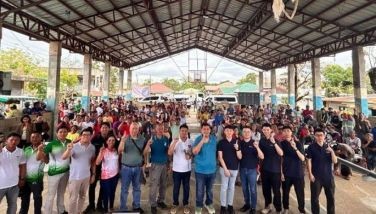Dance of Faith
I liken faith with the way we regard the force that runs the compass. It defies all our senses: we can’t see it nor hear, touch, taste or smell it. But we know it’s there because we can see its workings. Airline pilots rely so much on this force to guide them at every flight. They trust it with their own lives and those of their passengers.
Actually, all of us who travel by plane also trust this invisible, intangible force. As we step aboard the aircraft, we stake our lives on the belief that the force is there and it’s working properly, always. We won’t even bother to ask the pilot if he had checked his cockpit instruments for functionality. We just trust he did.
It’s the same with our faith in God. We can’t see or touch God. But with faith, we can feel Him and know He is there.
The ways in which we express our faith in God are as many, and as diverse, as the number of the faithful. Different people do things differently, and that includes their manners of worship. We even do similar things for our own, different reasons. And the practices which we think work for us become a habit, a way of life.
Religion is one area where diversity and outward manifestations of inner yearnings are common. We have different reasons for doing the rituals of our faith – to appeal for favors, to give thanks, to seek forgiveness for trespasses done, to give praise and so on. We have our own, individual ways of worship.
All believers pray; they believe that praying works. And many will attest to the good effects of prayer in their lives. Alfred, Lord Tennyson wrote: “More things are wrought by prayer than this world ever dreams of.”
I’ve met, by chance, a cancer survivor who regularly visits indigent patients in a government hospital. She would talk to the patients themselves or to their attending families. She would offer some money for their needs, and a listening ear for their troubles. It’s her little way, she says, of helping in God’s enormous work on earth.
She does not seek for God to do something for or to her, but rather for Him to do something through her. Such attitude might seem totally selfless. But, as the woman herself reveals, caring for the sick diverts her attention from her own ailment. That’s her motivation.
Her work with the poor patients has brought her a sense of purpose and kept her busy. In the process, the cancer which once seemed overwhelming to her has now become a mere side issue. That, effectively, is healing, because it lightens her suffering.
Another woman I know never fails to gaze at the sunset, except only when the weather is really bad. It sustains her, she claims. The view reminds her of the sheer enormity of God’s power. Looking up at the blazing sky, she feels the nourishing, loving embrace of the divine.
This elderly lady still goes to the market by herself, walks her dog at the nearby park every morning, sweeps her own yard. She’ll be 99 in May.
The Bible has a prescription of how we should pray: positively and all-out, affirming that, even as we prayed, God is already answering. Some may find murmuring prayerful words to be prayer enough. Others may be inspired to go out and touch lives, to exemplify the tenets of their religion — in a sense, to really dance their faith and not be content with simply hearing the breath of God in their heads.
There is a more literal “dancing of the faith” that people do, especially here in Cebu. Devotees of the Santo Niño perform the “sinulog,” a ritual dance, as their special way of praying. Doing the dance requires one to overcome his inhibitions and self-centeredness, as it is to be performed in public. The momentary waiving of the self in prayer before God is a form of religious worship.
I’ve heard quite a good number of testimonies about the amazing effects of their dancing the “sinulog” in healing physical afflictions, in bringing prosperity and material abundance, in appeasing mental and emotional distresses. But these are only the practical benefits. Prayer, to me, must be ultimately intended for spiritual gains, which are of much bigger importance.
Believers say that their dancing the “sinulog” is a way of worship. Others worship by attending church services or taking a quiet time in prayer or doing service to God’s other children – many different ways. Some people choose to do one, others two, and others still do it all.
In the end, what’s more important perhaps is that we don’t worship God only occasionally but to make our whole lives the full occasion for doing it. Our flames of our faith shall not only dance during the Sinulog – but at every moment of our lives.
- Latest




























